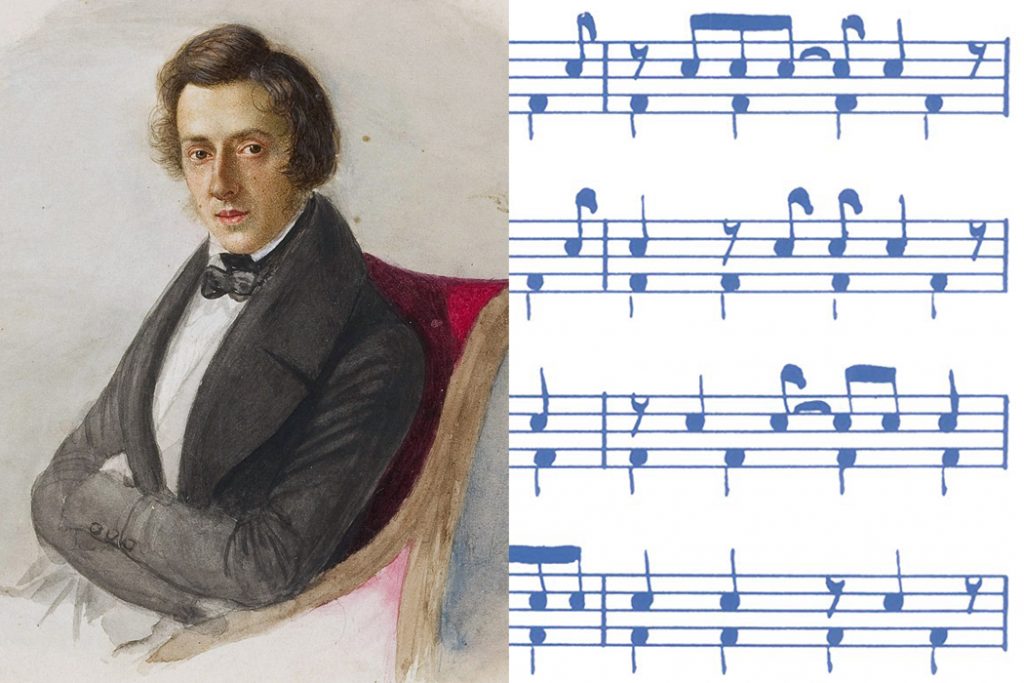+ Take your modern jazz piano and hip-hop beat making to new heights with Soundfly’s new course, Elijah Fox: Impressionist Piano & Production!
This article originally appeared on Ethan Hein’s blog.
I’m trying to get better at understanding classical music, ideally without doing too much Schenkerian analysis.
I can hunt for cadences as well as anyone who’s been to music school, and I understand how important they are as structural elements in the Western canon.
A brief aside…
We just published a video about the different types of cadences on our YouTube channel.. It’s…pretty rad. Musicians, composers, and curiosity-junkies, check it out and subscribe if you like that sorta thing!
But there’s more to this music than harmony. It has rhythm too, and I’m curious to know who’s studying that aspect.
While digging through Google Scholar results, I found John Rink’s rhythmic analysis of Chopin’s “Étude Op 10 No. 3.” This is the one where Chopin starts with one of his loveliest, most achingly wistful melodies, and then inexplicably launches into Cloud Cuckooland. Here’s a recording by Maurizio Pollini.
I was unsurprised to learn from Wikipedia that the main melody has been repurposed for many pop songs over the past 150 years, though they tend not to use the crazy part. An example:
Rink argues that the Étude does actually make sense, even the crazy part, though you might not ever guess this from listening to the way that people typically perform it.
“Where I have found this Étude problematic as both a performer and an analyst is in knowing how to treat [the crazy part], and also in justifying what I have tended to regard as an explosion of activity in the middle section—one which, at least in most performances, seems entirely at odds with the lyricism and comparatively contained passion of the outer sections.
Pianists tend to let loose in the middle, playing with increasing intensity as the music becomes more chromatic, and reaching fever pitch at the tortuous, jagged descent starting in measure 46. It is of course marked con bravura, but the dynamic marking is only forte, not fortissimo or louder. The fact that one regularly hears the middle at extreme levels of intensity and velocity only perpetuates a widespread misconception about the piece.” (pp. 133-134)
Rink wants you to think of the crazy part as actually being closely connected to the mellow part. However, the connection is rhythmic rather than melodic or harmonic. In order for it to make sense, performers should be playing the rhythms as Chopin wrote them.
They don’t generally do this at all. Since it’s customary to be very free with the time in this kind of music, performers can place emphases wherever they feel like it. Rink complains that when they do this in the crazy part, they naturally emphasize the functional chords, regardless of where they fall in the bar.
+ Learn how to marry theory, improvisation, and beat making to become a better pianist and producer, with Grammy-winner Kiefer’s Keys, Chords, & Beats.

But Chopin places the chords on particular beats for a reason.
“My own approach to the climactic passage is to observe Chopin’s rhythmic notation strictly at the start—or as strictly as the physical distance that must be traversed permits—rather than lengthening the first chord in the manner one typically hears, as in the recordings of such celebrated pianists as Alfred Cortot and Vladimir Ashkenazy.
In both cases, unsettling rhythmic anomalies follow at the end of the phrase, mainly because the accentual scheme imposed by each pianist and the sheer level of intensity end up driving the descent and, ironically, over- stabilizing it, not least by heavily accenting the descent’s structural chords. In my view, it is better to treat the rhythm of the first chord literally as a sixteenth note, and then to play the first chord in each pair not as accented “downbeats,” but with the stress arising from syncopation, which purposefully destabilizes the music at the foreground level but allows for stability, or at least balance, at a further remove.
Everything falls into place when one retains the underlying pulse in the back of one’s mind, no matter how distant it becomes on the surface, all the while keeping a lid on the energy, particularly in terms of dynamics. The key, then, is to play the repetitive chordal patterns in measure 52 as syncopated, thereby destroying any false stability which may have arisen as the descent progresses. This also paves the way for the passage that follows, where metrical regularity is restored even as the inner syncopation pattern itself infuses the music with momentum, allowing it to become more than just a link between two otherwise irreconcilable sections.” (pp. 137-138)
Valentina Lisitsa’s performance is a more chilled out than the ones Rink is complaining about, and you can hear more clearly how the crazy part is organized.
Dmitry Shishkin is also nice and mellow on the dynamics, but he is still looser with the time than I (and probably Rink) would like.
Rink doesn’t just think you should pay attention to the syncopated rhythm in the crazy part. He sees that syncopation as the organizing principle behind the whole piece.
“I see this piece as a study not in legato melody (as some have claimed), but in controlling syncopation from the level of detail to the level of form. What I mean is that the piece as a whole is a massive expansion of the very properties contained within the first three notes of the left-hand part. Not only does each outer section last more or less half as long as the middle one, just as each sixteenth note in the first left-hand beat lasts half as long as the accented eighth note in the middle (in both cases in a ratio of 1:2:1), but the eruptive middle section is itself like a massive syncopation at the level of form, proportionally corresponding in rhythmic and expressive function to the accented, syncopated eighth note in beat 1 of the piece.” (p. 134)
In order for me to hear the syncopations with maximum clarity, I used Ableton Live to quantize the Pollini recording to a steady tempo, and paired it with the Amen Break. It came out sounding pretty excellent!
I warped the Pollini recording in Beats mode on purpose. When you slow audio down in Live, it divides it into little windows and spaces them out. Then it has to somehow fill the gaps between each window. Live’s warp modes differ in how they generate their filler material. When you select Beats mode, Live fills the gaps by repeating material at the each transient (or at the rhythmic interval you specify). I love the stuttery effect you get from pushing this setting too hard.
Beyond their own appealing glitchiness, the time-stretching artifacts also give you an aural indication of how far from metronomic time Pollini’s performance is from moment to moment. The more he rushes in his recording, the more artifacted the sound is when forced back onto the grid.
I wish I had thought of this idea of remixing canonical classical works a lot sooner. It’s been quite a revelation for me. I’ve been keeping my remixes in constant rotation around the house, while I work, and so on.
I’ve never listened to so much classical music, and so closely. When it sounds like the music that I actually like, I’ll happily listen to it all the time, what a surprise. I don’t know if every canonical masterpiece is improved by the addition of some well-chosen beats, but it’s worked for every one I’ve tried so far.
Quantizing the music flattens out a lot of the performer’s expression, naturally, but that can be a positive; I feel like I have more room to participate imaginatively in what I’m hearing. In a way, the quantized version is like listening to the score itself, or, more accurately, to the MIDI version of the score, except with better instrument sounds and more nuanced dynamics. I find it easier to memorize the quantized versions, and they more readily play in my head when I’m not listening to them.
I guess I could listen to the quantized versions without the beats, but what’s the fun in that? Besides, I’m enjoying inhabiting this alternate universe where classical music feels the funk.
Play Your Heart Out!
Continue your learning adventure on Soundfly with modern, creative courses on songwriting, mixing, production, composing, synths, beats, and more by artists like Kiefer, Kimbra, Com Truise, Jlin, Ryan Lott, RJD2, and our newly launched Elijah Fox: Impressionist Piano & Production.




